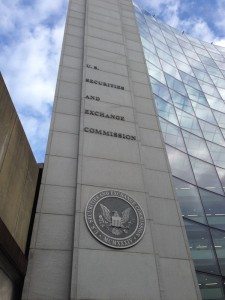 The SEC has approved the long awaited tick size pilot program. The proposal by the national securities exchanges and the FINRA is for a two-year test that will widen the minimum quoting and trading increments–or tick sizes–for stocks of some smaller companies. This pilot program will be utilized to assess whether wider tick sizes enhance the market quality of these stocks for the benefit of issuers and investors. The tick size pilot will begin by May 6, 2016.
The SEC has approved the long awaited tick size pilot program. The proposal by the national securities exchanges and the FINRA is for a two-year test that will widen the minimum quoting and trading increments–or tick sizes–for stocks of some smaller companies. This pilot program will be utilized to assess whether wider tick sizes enhance the market quality of these stocks for the benefit of issuers and investors. The tick size pilot will begin by May 6, 2016.
While the shift to tighter bid / ask pricing for stock purchases was initially viewed as a positive step for consumers, the law of unintended consequences eliminated much of the ability for market makers to generate any revenue on illiquid shares thus decimating the market for equity in some smaller listed companies. Some industry followers believe a wider tick size may encourage market makers to re-enter these markets.
“The data generated by this important market structure initiative will deepen our understanding of the impact of tick sizes on market quality and help us consider new policy initiatives that can improve trading in the securities of smaller-cap issuers,” said SEC Chair Mary Jo White.
 The SEC modified several provisions of the proposal submitted by the exchanges and FINRA that take into account input from commenters. For example, the SEC extended the pilot to two years rather than one, removed the venue limitation from the trade-at prohibition that would have required price matching executions to occur where the person’s quotation was displayed, and reduced the size of block transactions eligible for the exception to better reflect trading in smaller-cap stocks. The SEC also modified the market capitalization threshold for securities included in the tick size pilot and revised certain data elements concerning market maker profitability to make the collection less burdensome and assure the protection of confidential business information.
The SEC modified several provisions of the proposal submitted by the exchanges and FINRA that take into account input from commenters. For example, the SEC extended the pilot to two years rather than one, removed the venue limitation from the trade-at prohibition that would have required price matching executions to occur where the person’s quotation was displayed, and reduced the size of block transactions eligible for the exception to better reflect trading in smaller-cap stocks. The SEC also modified the market capitalization threshold for securities included in the tick size pilot and revised certain data elements concerning market maker profitability to make the collection less burdensome and assure the protection of confidential business information.
The pilot will include stocks of companies with $3 billion or less in market capitalization, an average daily trading volume of one million shares or less, and a volume weighted average price of at least $2.00 for every trading day.
The pilot will consist of a control group of approximately 1400 securities and three test groups with 400 securities in each selected by a stratified sampling. During the pilot:
- Pilot securities in the control group will be quoted at the current tick size increment of $0.01 per share and will trade at the currently permitted increments.
- Pilot securities in the first test group will be quoted in $0.05 minimum increments but will continue to trade at any price increment that is currently permitted.
- Pilot securities in the second test group will be quoted in $0.05 minimum increments and will trade at $0.05 minimum increments subject to a midpoint exception, a retail investor exception, and a negotiated trade exception.
- Pilot securities in the third test group will be subject to the same terms as the second test group and also will be subject to the “trade-at” requirement to prevent price matching by a person not displaying at a price of a trading center’s best “protected” bid or offer, unless an enumerated exception applies. In addition to the exceptions provided under the second test group, an exception for block size orders and exceptions that mirror those under Rule 611 of Regulation NMS will apply.
Data generated during the tick size pilot will be released publicly on an aggregated basis to assist in analyzing the impact of wider tick sizes on smaller capitalization stocks. The exchanges and FINRA will submit their initial assessments on the tick size pilot’s impact 18 months after the pilot begins based on data generated during the first 12 months of its operation.

